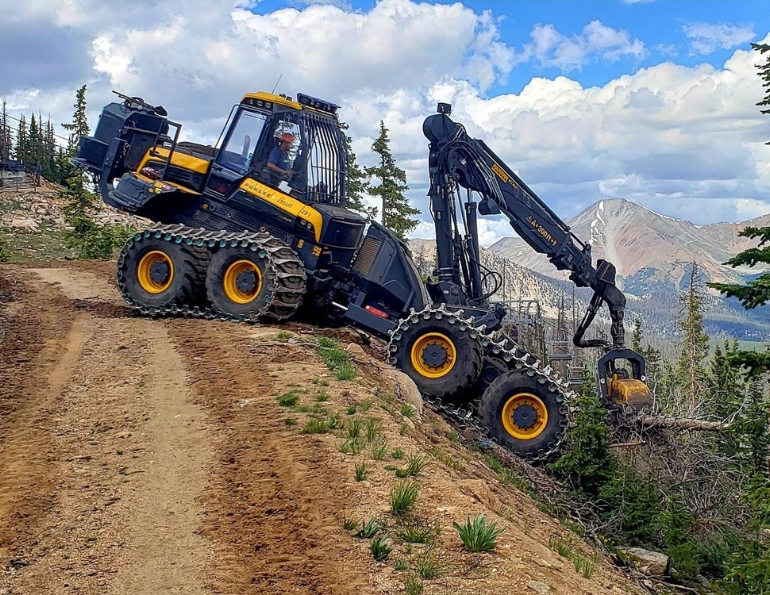Forest health is at the heart of sound and sustainable ski area management. The maintenance of a healthy forest through practices like thinning, prescribed burning, mechanical removal, and revegetation supports a variety of goals. These vegetation management practices reduce wildfire risk, protect infrastructure, ensure public safety, maintain water quality and quantity, reduce pest impacts, and even improve aesthetics. At many ski areas, these goals intersect.
But vegetation management projects are not without hurdles. Often, the timelines are long, the regulatory processes cumbersome, the costs significant, and the ROIs less tangible than the “simple” math of, say, a capacity expansion.
Nonetheless, in the last decade, the need for proactive forest management has become increasingly important. Wildfires, insect infestations, and climate change all threaten forest health and resilience. These factors fuel public safety and infrastructure risks at mountain resorts and beyond.
How do ski areas identify the need for vegetation and fuels management? What are the challenges and opportunities of implementing these projects? Why does investing in forest health matter? Leaders at Monarch Mountain and Winter Park, Colo., and Sun Valley, Idaho, answer these questions and more.
IDENTIFYING A NEED
Sun Valley, Monarch, and Winter Park have all dealt extensively with vegetation management for years, even decades. While different threats drove the need for a vegetation and fuels management plan at each resort, there are similarities in their experiences of identifying concerns and assessing the scope of the damage.
SUN VALLEY: DOUGLAS-FIR BEETLE AND FIRE RISK
Sun Valley, in Idaho’s Sawtooth National Forest, had been active in removing hazard trees throughout the ’80s and onward. “Our philosophy has always been that as a permittee, and owners of significant infrastructure, our success was dependent on stewardship of the forest,” says Peter Stearns, strategic adviser to the Sun Valley Company and former longtime director of mountain operations.
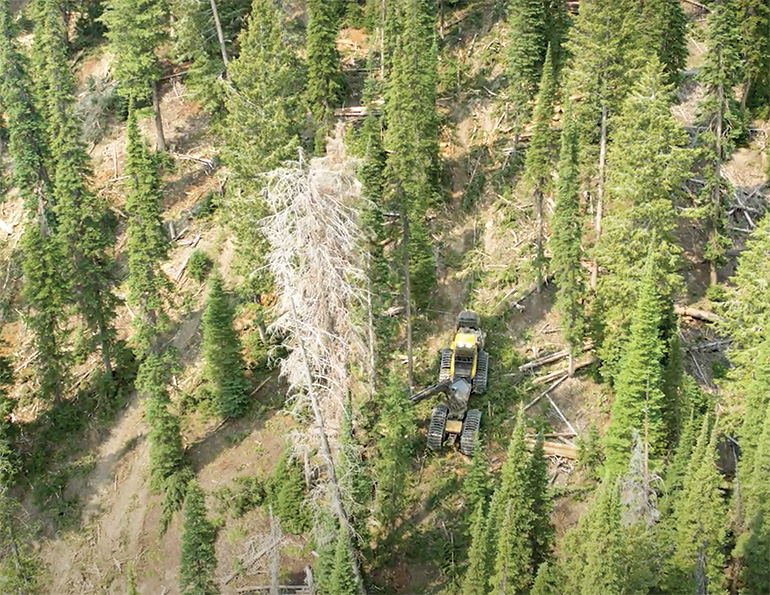 Sun Valley harvests hazard trees, cutting them to length at the site before hauling them out.
Sun Valley harvests hazard trees, cutting them to length at the site before hauling them out.
Escalating mortality due to the Dwarf Mistletoe parasite and approximately eight years of drought left older forest stands at the resort vulnerable to insects and disease, though. The 2007 Castle Rock and 2013 Beaver Creek fires near the permit boundary made the ski area susceptible to a Douglas-fir beetle infestation, which led to substantial tree mortality and increased fire risk.
To address the mortality, Sun Valley tried several methods. At first, it yarded just hazard trees, as it had throughout its history of forest management. “This resulted in minimal impacts toward any significant overall change,” says Stearns. Application of lop and scatter treatments followed, then mastication treatments for several years. But both methods just rearranged the fuels, leaving scattered vegetation debris rather than removing them from the site, Stearns explains.
To better manage the fuels and improve forest health, six years ago, Sun Valley turned to a cut-to-length (CTL) strategy. In this harvesting method, trees are felled, delimbed, and cut to length at the site before being transported away (as opposed to whole-tree harvesting, where entire trees are removed and processed at a different location). Following a substantial environmental assessment in 2020, the project ramped up to include 3,331 acres of the Bald Mountain Ski Area Special Use Permit area as well as several thousand acres outside the permit boundary.
MONARCH MOUNTAIN: SPRUCE BEETLE AND A BROADENING SCOPE
In 2012, the USDA Forest Service identified that a Spruce Beetle endemic was moving from southwest Colorado into Monarch Mountain, which operates within the San Isabel and Rio Grande National Forests. The impacts of the infestation were minimal for the first few years, but by 2015 began to increase significantly, with larger diameter trees—12 inches or bigger—experiencing close to 90 percent mortality.
The resort’s initial approach focused on addressing dead standing trees primarily near lift corridors and infrastructure. But Monarch soon recognized the scope of the issue required a larger response.
“We started asking the Forest Service more and more to mark trees for hazard mitigation next to our lift infrastructure, and kept pressing them for a bigger solution,” says vice president of mountain operations Scott Presley. In 2018, the Forest Service developed the Monarch Pass Vegetation Management project, a landscape-scale approach that extended across Monarch’s boundary and into adjacent public lands.
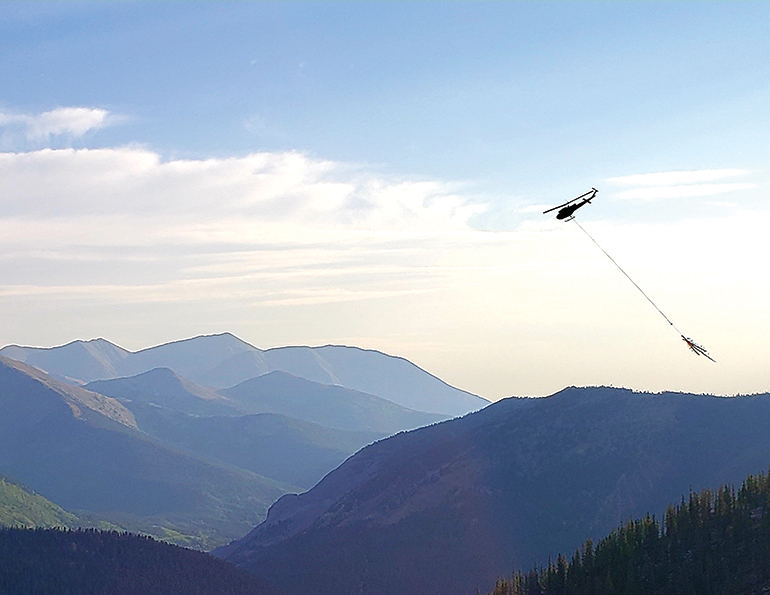 Monarch relies on helicopter removal for tackling trees on more difficult terrain that traditional logging equipment cannot access.
Monarch relies on helicopter removal for tackling trees on more difficult terrain that traditional logging equipment cannot access.
The idea of the sprawling project was to be proactive about fire risk mitigation and skier safety by removing dead timber on a large scale while it was still standing. “Obviously, we want to maintain a viable skiable product,” explains Presley. “Having your woods be a jack straw [full of fallen trees] is not only hazardous, but it can be borderline unskiable for our guests.”
Monarch started with thinning the “low hanging fruit,” i.e., the stands on lower-angle terrain. This could be tackled with traditional logging equipment and was “the best bang for our buck to start,” says Presley. In subsequent summers, the resort has hired contractors to tackle more difficult terrain with helicopter removal and winch-assisted machinery.
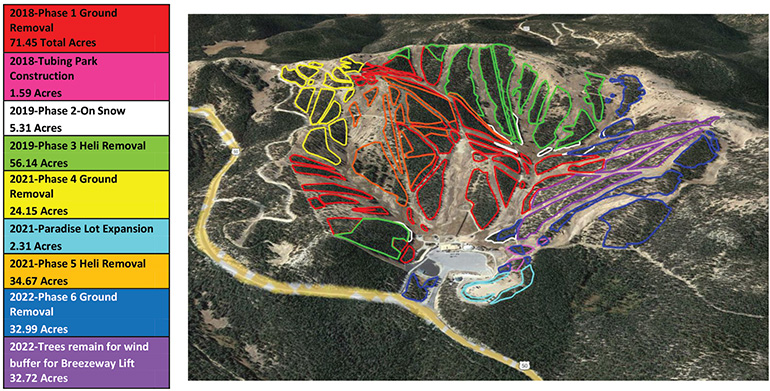 Monarch Mountain’s Forest Health and Fuels Reduction Map (2018-2022) shows the resort’s phased approach to treatment.
Monarch Mountain’s Forest Health and Fuels Reduction Map (2018-2022) shows the resort’s phased approach to treatment.
WINTER PARK: PINE BEETLE AND ANNUAL APPROACH
In the early 2000s, Winter Park, which operates in the Arapahoe and Roosevelt National Forests, became aware that a mountain pine beetle infestation was encroaching. In response, the area updated its master plan with proposed forest management action and supporting NEPA documentation for areas likely to be impacted by the insects.
In the beginning, says resort planning director Doug Laraby, the focus was on cutting down pockets of infestation per the master plan. In 2010, though, a forest ranger proposed a larger environmental assessment that included both Winter Park’s permit boundary as well as several thousand adjacent acres.
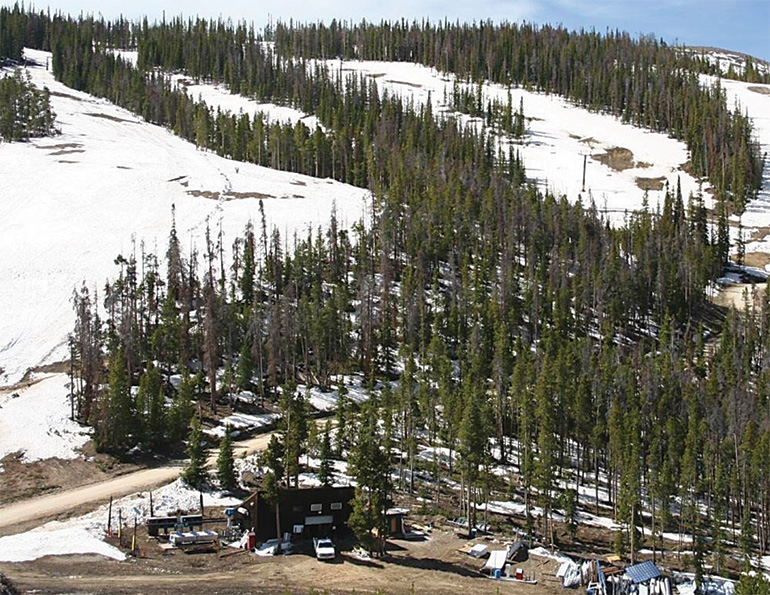 Before tree removal in the Railyard area at Winter Park.
Before tree removal in the Railyard area at Winter Park.
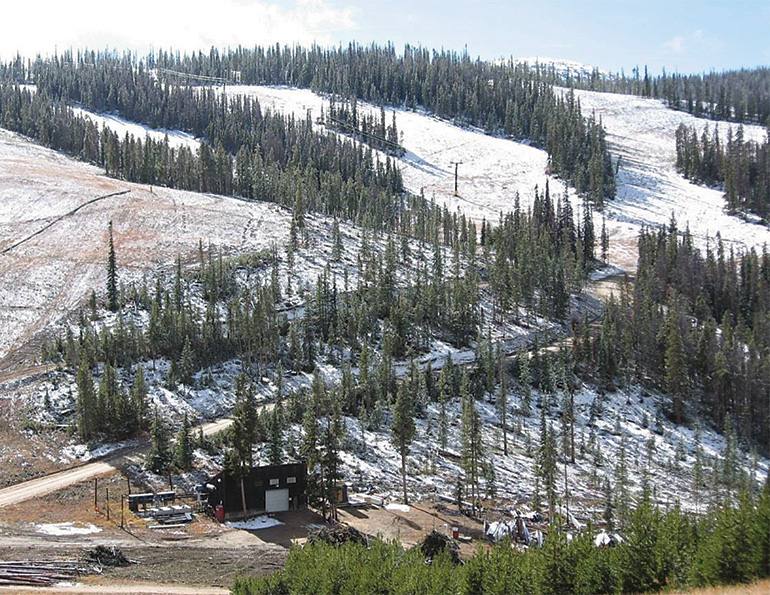 After tree removal in the Railyard area at Winter Park in 2010.
After tree removal in the Railyard area at Winter Park in 2010.
The assessment called for widespread treatment across the resort, which Winter Park has approached in segments. “Basically, we’ve chipped away at these dead trees since 2005, and we’ve done it every year,” says Laraby. “We spend $100,000-$150,000 a year.”
The annual investment is necessary for several reasons. First, the need to mitigate fire risk. There is also the public safety concern, and the unappealing visual of a resort filled with dead standing timber. Finally, there’s a need to protect water quality. The resort is in a watershed for the town of Winter Park and Denver Municipal as well as several local water and sanitation districts. Forest mortality can affect watershed health through reduced water uptake, soil erosion, reduced water quality, and of course, fire risk.
BENEFITS OF COLLABORATION
The multitude of reasons for tackling forest health at Winter Park—and in the surrounding forest—attracted a wide network of stakeholders, which had benefits in respect to financing. In particular, the resort received watershed-related grant funding several years in a row. Denver Water, the town of Winter Park, and other local water and sand districts all contributed money to the efforts as well.
Sun Valley, too, saw a positive community response for vegetation management. “Later in the process, as the forest decay increased and became more apparent, the public awareness, concern, and involvement escalated and drove multiagency and community stakeholder solution-based collaboration,” says Stearns.
The collaborative process is unprecedented in the resort’s history, he notes. The USFS, Bureau of Land Management, National Forest Foundation, Sun Valley Company, Miller Timber Services, and private citizens groups all worked as a coalition. This has allowed for the leveraging of both private (the resort as well as local fundraising) and federal funding, “and it’s becoming apparent that there is an appetite for projects such as the ones we are doing,” says Stearns.
While Monarch has funded all its forest management work from its own budget, collaboration with the Forest Service still had positive outcomes for the resort. The development of the Monarch Pass Vegetation Management project, for example, led to a categorical exclusion (CE) that expedited the environmental review process and allowed for a more comprehensive treatment plan. “This pretty much gave us the green light to thin and glade [create gaps in the canopy] every stand on the mountain versus just a select few from our 2011 master development plan,” explains Presley.
FOOTING THE BILL
Funding can be a challenging component of vegetation management planning. In the U.S., there has been notable new government spending aimed at improving forest health and sustainability on public and private lands. This includes significant funding in recent years for the U.S. Forest Service and the Department of the Interior for wildfire prevention and suppression efforts, as well as funding for forest restoration and conservation programs. That funding isn’t necessarily available to special use permit holders, though.
Historically speaking, the landscape around forest management saw a shift during the Reagan era, as the administration pushed for the increased privatization of public lands. For special use permit holders, explains Stearns, “Reaganomics put the responsibility upon the permittees for vegetation management and associated treatments.”
Managing these costs after a major forest mortality event is one significant reason that the resorts we spoke with have taken a phased approach to thinning projects, which become more expensive as they move into steeper terrain and away from existing access roads, requiring more specialized equipment, such as helicopters. “Generally, we offset that by just doing a smaller acreage total for the helicopter removal years,” says Presley.
The long game has a major downside: Trees that are affected by drought, insects, or fire have a limited window in which they are still considered valuable—and saleable.
“In the first couple summers, we were pulling out merchantable timber, which would help offset some expenses. Now, it’s mostly firewood,” Presley notes. “Most people think we’re making all kinds of money off the wood we’re harvesting. That’s not the case—we’re basically just trying to get rid of it.”
Laraby says, in hindsight, he might have approached Winter Park’s forest management differently than chipping away at small area by small area. “If you were to do it from the get-go, you would cut as many trees as you possibly could, with the value that they had [in those early days],” he says. “That would help stop the spread of the infestation and allow the resort to recoup some of the project costs.”
LIMITATIONS AND RESTRICTIONS
Even with the bulk of the timber removed offsite, resorts are still left with a fair bit of slash—the debris left from logging operations—to deal with. While slash can have positive effects on a forest ecosystem, it can also dry out and become highly flammable. Pile burning is a typical way to manage fuels that are unsafe, but comes with some considerations.
Operators need snow to conduct a burn safely. And sometimes, that snow is the storm that will get a resort open for the season. So it’s necessary to build slash piles well away from early season operations.
Air quality concerns can also factor into the windows for burning. “We have our own state permit for air, which conflicts with the county’s—the county doesn’t allow people to burn early season because there’s not enough snow on the ground,” says Laraby.
In all phases of a forest management project, wildlife can be a limitation. “Wildlife, migratory birds, elk calving, etc., present narrow treatment windows,” says Stearns. “This presents challenges for treatment contractors economically, due to the high cost of operations during short performance windows.”
Another obstacle: Even with all the productive collaboration between stakeholders, Stearns notes that the “differences in agency toolboxes” and the limitations of the available tools can be cumbersome. For example, says Stearns, different agencies like BLM and the USFS require different processes, and tools such as those that exist for traditional timber sales don’t necessarily fit the purpose or meet the objectives of forest health, fuels, and recreation projects (rather than sales projects).
Complicated prescriptions on paper can threaten the feasibility of a project in the field as well. “The main NEPA document done by the Forest Service [for Winter Park] had some 14 different types of prescriptions,” says Laraby.. “So, it got pretty complicated, to the point where our loggers wouldn’t do it.” To comply, Winter Park had to simplify the plan.
A CHANGING LANDSCAPE
Thinning trees means changes both positive and negative to the landscape. For example, at Monarch, “the way the wind affects the mountain has changed,” explains Presley. “The areas of loading have changed. We’ve built a lot more snow fences in areas where the tree stands would [previously] kind of work as snow fences. The top of our lifts are more exposed now, too.”
On the flip side, Sun Valley’s CTL strategy has had a recreation benefit, says Stearns, creating heightened safety from hazard tree removal and as well as nearly 380 acres of new glades. “The public is not only aware, but ecstatic about the experience,” he adds.
For Winter Park, in addition to improved “visuals” and reduced fire risk, its vegetation management project has also had a positive impact with guests and the community. “The public has been very supportive,” says Laraby. “They want a healthy mountain.”
Regeneration and revegetation efforts are part of achieving a healthy mountain. At Monarch, that has involved planting new trees—1,200 last year and another 2,000 this year—with an eye toward rebuilding some of its wind barriers. “We involved the public last year,” says Presley. “We got a local kids group up here planting trees, so that was a nice little community event.”
As new growth emerges, “the thing that needs to be remembered is you might have to go in and start treating the areas that have been revegetated, because they’re too thick, or too tall,” says Laraby. “We want to treat those areas, so we don’t have a pine beetle problem in the future.”
And the need for forest management doesn’t end upon completion of a plan. “It’s just like having a house,” says Laraby. “You have to paint the south side every so often, and you have to fix a leaky faucet here and there. You need to be active in your forest. It’s an important part of your ski area.”
And it’s an important responsibility that ski areas should, and do, take seriously. “As a special use permit holder operating a business on public land,” says Stearns, “we recognize our role as a steward for the land within that permit area. As a member of the community, we also recognize the importance for us, along with other partners, to participate in efforts towards the project area obtaining desired future conditions.”





